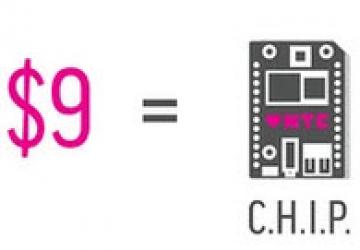Goodbye, Pi. Hello, C.H.I.P.

1. It's completely open source. I don't just mean the software, either. The design and documentation are completely open source, so people can download the schematics and make their own version, adding improvements or tweaking the design.
2. The operating system is based on Debian, which means that it supports thousands of apps out of the box.
3. Its single core CPU runs at 1GHz, beating the Pi's 700MHz CPU.
4. It has double the RAM--512MB instead of 256MB.
5. It has 4GB of storage built in.
6. It has built-in Wi-Fi.
7. It has built-in Bluetooth.
8. It can connect to almost any screen. The base unit supports composite video output, and there are adapters for VGA and HDMI.
9. There is an optional case that adds a touchscreen and a keyboard. It's the size of the original Game Boy.
Of course, this isn't the first Raspberry Pi competitor to offer more features than the original, but there's one big difference. Whereas all of the others have been more expensive than the Pi, this one is cheaper. Much cheaper--the basic unit is only $9.
The project was launched on Kickstarter on May 7, 2015, with a modest $50,000 target, which it smashed within hours. As I write this, the total pledge is $1,329,290, and there are less than three weeks left to go.
As you read this, the figures are bound to have changed, so here's a link for you to check it out directly: https://www.kickstarter.com/projects/1598272670/chip-the-worlds-first-9-computer/video_share.
With a smaller profile than the Pi, a lower price tag, a more powerful processor and more memory, it could quickly replace Pi as the number-one choice for projects.
It's packed with pins and sockets to help build whatever your imagination cooks up. It has:
- Parallel LCD output.
- Eight digital GPIOs.
- One PWM pin.
- SPI.
- TWI (I2C).
- UART.
- USB.
- MIPI-CSI.
- Touch panel input.
- Stereo audio out.
- Mono audio in.
- Composite video out.
They are continuing to tinker with the specifications leading up to the official release, so keep an eye on those.
The official public release is scheduled for next year, but crowdfunding backers will be able to land a "Kernel Hacker" package this September. This package is aimed at Linux developers who want to help to contribute to kernel modifications for the C.H.I.P. before its final release.
Once the crowdfunding project is completed, they will be releasing all the design docs to the community, so you can expect to see a number of similar devices popping up in the future!









